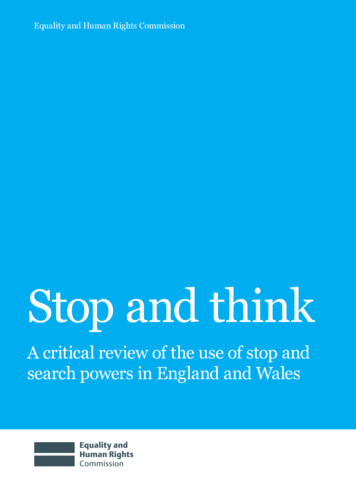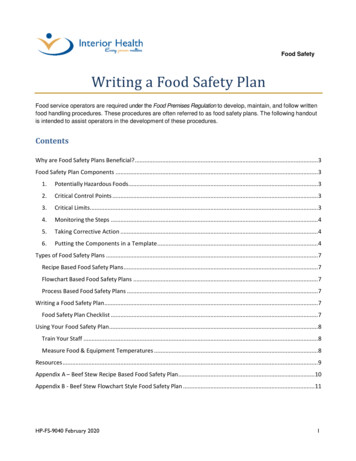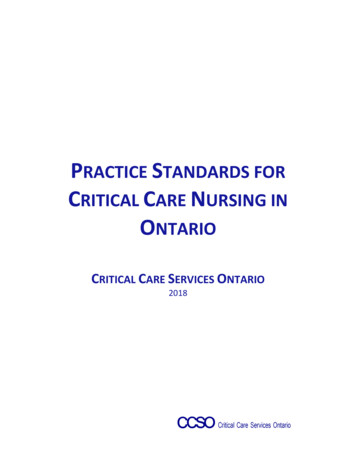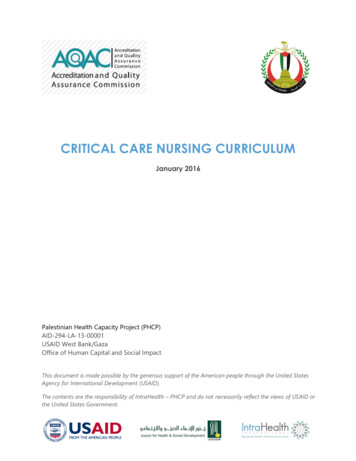
Transcription
Equality and Human Rights CommissionStop and thinkA critical review of the use of stop andsearch powers in England and Wales
Stop and thinkContentsForeword3Acknowledgements4Section 4:Emerging good practiceThe Next Steps initiativeExecutive summary5Case study: Operation PennantSection 1:IntroductionStop and search: what is itgood for?The role of the CommissionA brief history of stop and searchThe legal frameworkThe remit of this reportCase study: Ken Hinds81112121517656668697071Case study: Cleveland police73Appendix: Statistical tables74Endnotes106Contacts11019Section 2:20Stop and search statistics222.1 Introduction2.2 Results using the Ministry of24Justice approach2.3 Adjusting for ethnic36population changes462.4 ConclusionsCase study: Staffordshire police 49Section 3:Can disproportionality bejustified?‘Street availability’Crime ratesData accuracyEffectivenessDiscrimination: a continuingproblemPolicing strategyConclusionSection 5:Conclusion and recommendationsThe need for real changeParticular areas of concernMoving forwardOur vision of ‘good enough’policing60625052545556565858
www.equalityhumanrights.comForewordThe police play a vital role in defending some of our mostfundamental human rights. They are guardians of the right to libertyand security, and safeguard the right to life, the ultimate humanright. The police support our ability to live free from violence, crimeand fear, and help create an environment within which other rightsand freedoms can be enjoyed.In seeking to protect the rights of themajority, the police at times infringe certainindividual rights, such as the right to privacyor to freedom of movement and association.However, they are only permitted to do so ifthe infringement is rational, proportionateand lawful. Yet the evidence shows that, onthe contrary, some police forces are usingtheir powers disproportionately suggestingthey are stopping and searching individualsin a way that is discriminatory, inefficient,and a waste of public money. This is despitethe evidence from both Staffordshire andCleveland which proves that a reduction inthe use of stop and search can go hand inhand with a reduction in the overall levels ofcrime. Staffordshire and Cleveland showthat policing which respects human rights ismore effective and actually makes us safer.The evidence in ‘Stop and think’ suggeststhat some forces are exercising their powersnot on the basis of intelligence or reasonablesuspicion but on stereotypical assumptions,which is not helping to make society safer.Black people are at least six times as likely tobe stopped as white people; Asian people,around twice as likely.Such an approach to policing erodes trustand makes co-operation harder, not justbetween police forces and the groups whoare singled out, but also among the widerpublic, who are ill at ease with the idea ofthe state intruding unnecessarily intoindividuals’ private lives and their freedomto go about their business.This is why the Equality and Human RightsCommission wants to see an end to thedisproportionate use of stop and search.We hope to work with the police to makeprogress through advice, guidance,encouragement, and, where necessary,enforcement. Respecting human rightsassists good policing and effective crimecontrol and creates a safer society for us all.Professor Geraldine Van Bueren,Commissioner, Equality and HumanRights CommissionSimon Woolley,Commissioner, Equality and HumanRights Commission3
Stop and thinkAcknowledgementsThis report is the result of the Commission’s work to review the disproportional impact ofstop and search on black and Asian people in England and Wales.We would particularly like to thank Professor Ben Bowling, Professor of Criminology andCriminal Justice at King’s College London, for taking part in the project and sharing withus his extensive knowledge of research into stop and search.We would also like to thank the following Commission staff for their contributions: PhilPavey, Policy Manager Justice and Safety, who has worked for many years on these issues;Dr Karen Hurrell, Senior Statistician, who carried out the statistical analysis; MaryCunneen, Senior Lawyer, for her advice; Dr Marc Verlot, Foresight Director and Head ofCriminal Justice and Safety Policy, who took the overall lead of the work; as well as AliceO’Keeffe and Rachael Bolden who helped with writing, editing and print production ofthe report.4
www.equalityhumanrights.comExecutive summarySection 1: Introductionnn The figures are stark: if you are a blackperson, you are at least six times aslikely to be stopped and searched by thepolice in England and Wales as a whiteperson. If you are Asian, you are aroundtwice as likely to be stopped andsearched as a white person.nn Despite years of debate and severalinitiatives aimed at tackling the problem,these ratios have stayed stubbornly high.nn The majority of stops and searches inEngland and Wales are conducted underthe Police and Criminal Evidence Act(PACE). The Commission believes thatthe current police use of PACE stop andsearch powers may be unlawful,disproportionate, discriminatory anddamaging to relations within andbetween communities.nn We will consider taking enforcementaction if we believe police forces are notsufficiently addressing this problem.Section 2: Stop and searchstatisticsnn Using data from the Ministry of Justice,the Home Office, the Metropolitan Policeand the Office for National Statistics wehave analysed trends in stop and searchuse around the country.nn For each force we look at two measures:the disproportionality ratio, whichtells us how much more likely black andAsian people are to be stopped andsearched than white people; and thenumber of ‘excess’ searches, whichtells us how many more stops andsearches are conducted on black andAsian people than would be the case ifthey were stopped and searched at thesame rate as white people.nn There is a large degree of consistencyover time – geographical patterns in theuse of stop and search have persistedover many years.nn Some of the highest black/whitedisproportionality ratios are seen inDorset, Hampshire and Leicestershire.In Hampshire the ratio increaseddramatically in 2007/08.nn Some of the highest Asian/whitedisproportionality ratios over the lastfive years are seen in the West Midlands,Thames Valley, West Mercia and SouthYorkshire.5
Stop and thinkThinknn The biggest impact in terms of numbersof ‘excess’ stops and searches is seen inLondon where the stop and search rate ishighest at 60 per 1,000 in 2007/08 andwhere a high percentage of the black andAsian population lives.nn For black stops and searches largeexcesses are also seen in the WestMidlands, Greater Manchester, WestYorkshire, Thames Valley, Leicestershireand Hampshire.nn For Asian stops and searches large excessesare also seen in the West Midlands, WestYorkshire and Thames Valley.nn Similar and/or neighbouring policeareas will often have very differentresults which cannot easily be explained.Section 3: Can racial differencesin the use of stop and search bejustified?nn Various explanations have been putforward as to why the police use stopand search powers so disproportionatelyagainst certain groups. Even takentogether, however, they provide nojustification for the extent andpersistence of the problem.nn One common explanation, that blackpeople are generally more ofteninvolved in crime is not supported byrobust evidence. In any case, stops andsearches should be carried out on thebasis of ‘reasonable suspicion’. It isunlawful for the police to base theirsuspicions on generalised beliefs aboutparticular groups.6nn While stop and search plays some role inpreventing and detecting crime, theimpact is small. It is estimated thatsearches only reduced the number ofdisruptable crimes by 0.2 per cent. Itsuse therefore needs to be balancedagainst the negative impact oncommunity confidence in the police ifthese powers are used unfairly.nn Strong differences between similar and/or neighbouring police areas indicatethat the way a particular police forceuses its stop and search powers may bemore significant than the nature of thecommunities it serves.nn The evidence points to racialdiscrimination being a significant reasonwhy black and Asian people are morelikely to be stopped and searched thanwhite people. It implies that stop andsearch powers are being used in adiscriminatory and unlawful way.Section 4: Emerging goodpracticenn Over the years several initiatives haveaimed to tackle this problem. Due topatchy implementation and lack ofconsistency, however, none has made thenecessary lasting impact on rates ofdisproportionality nationwide.nn The ‘Next Steps’ initiative, formulated bythe National Policing ImprovementAgency, and due for roll-out in 2010,may be effective if rigorouslyimplemented and monitored.nn However, launching new initiatives is nolonger enough. The police need to makereal improvements that are reflected inthe statistics.
www.equalityhumanrights.comSection 5: Conclusions andrecommendationsnn We are particularly concerned about forceswith high numbers of excess searches –particularly London forces – and thosewith persistently high black/whitedisproportionality ratios, such as Dorset.nn We will also be monitoring the figures toidentify forces in whichdisproportionality ratios or numbers ofexcess searches are rising, which hasbeen seen in Hampshire.nn We expect to see improvements within ayear. If there is little evidence of realchange the Commission will considerwhat further steps it needs to take toeffect change.nn For those forces who have demonstratedthe most significant and persistentdisproportionalities and excesses, weintend to take more immediate action.Following publication, we will becontacting several forces who havedemonstrated the most significant andpersistent disproportionalities andexcesses, with a view to takingenforcement action under the RaceEquality Duty, if necessary.nn It is unrealistic and unhelpful to demandthat policing should be perfect. Webelieve, however, that police servicesshould strive to work fairly andeffectively while respecting basic humanrights. Only then can they be said to be‘good enough’.7
Section 1:Introduction
www.equalityhumanrights.com‘Since 1995, per head of population inEngland and Wales, recorded stops andsearches of Asian people haveremained between 1.5 and 2.5 timesthe rate for white people, and for blackpeople always between 4 and 8 timesthe rate for white people.’9
Stop and thinkThe figures are stark: if you are black, you are at least six times aslikely to be stopped and searched by the police in England and Walesas a white person. If you are Asian, you are around twice as likely tobe stopped and searched as a white person.This has a huge impact on the experiencethat people from these groups have of thepolice: in 2007/08, black people weresubjected to around 150,000 more stops andsearches – the majority of the 172,000 blackstops and searches in total – than theywould have been if they were stopped andsearched at the same rate as white people.In the period of more than 10 years overwhich the statistics have been collected,the ratios have remained stubbornly high.1Despite years of debate and severalinitiatives aimed at tackling the problem,the police have still not achieved anysignificant improvement in their record onrace disproportionality in stop and search.In January this year, the European Courtof Human Rights (ECHR) ruled thatsearches undertaken under section 44 ofthe Terrorism Act 2000 were unlawful asthey were not based on ‘reasonablesuspicion’.2 The ruling has importantimplications for the police and for civilliberties in Britain. The Commissionbelieves, however, that there are muchwider problems with the police use ofstop and search powers.10The large majority of searches in Englandand Wales are conducted under the Policeand Criminal Evidence Act 1984 (PACE):around 1 million per year compared to256,000 in 2008/09 under section 44 ofthe Terrorism Act.3 Stop and search underPACE is also used more disproportionatelyagainst black people than those conductedunder the Terrorism Act. 4 We believe,therefore, that the police use of PACE is ofgreat significance in terms of its impact oncommunity relations. Furthermore, theevidence 5 indicates that PACE may bebeing used in a discriminatory andunlawful manner.Several explanations have been advancedas to the extent and consistency of racedisproportionality in stop and search,including theories that the data areinaccurate, that black people commit morecrime, or that they are more ‘available’ tobe stopped and searched than whitepeople. In this report we examine thesearguments and find them inadequate: eventaken together, they do not explain orjustify the extent and persistence of theproblem of race disproportionality.
www.equalityhumanrights.comA close examination of police force areafigures raises the issue of whether thedisproportionate rate that different racialgroups are stopped and searched is theresult of the practice of particular policeforces – whether by policy or custom.Forces that have adopted rigorousmeasures to tackle the issue have seenratios fall significantly, as we show in thecase studies in this report. A reduction indisproportionality does not have to resultin a rise in crime – on the contrary, in thecase of both Staffordshire (page 49) andCleveland (page 73) it has gone hand inhand with reduced crime rates andincreased levels of public confidence inthe police.This report does not cover the situation inScotland, as data published by theMinistry of Justice covers territorial forcesin England and Wales. The eight Scottishforces are not statutorily required togather or publish corresponding statistics.Stop and search:what is it good for?For the police, the power to stop and searchpeople who they suspect of being involvedin crime is an important tactic. It providesa means to confirm or allay suspicionsabout individuals without exercisingtheir power of arrest. Were it employedappropriately and proportionately, it couldincrease community confidence in thepolice and make a positive contribution toreducing the fear of crime.Stop and search has been widely used inrelation to knife crime. For example underOperation Blunt 2, up to October 2009,more than 380,000 stops and searcheshave been conducted; 14,700 people havebeen arrested; and more than 7,500 kniveshave been recovered.6For the use of stop and search to belawful and rights-respecting, it must be inaccordance with both human rights andequality law. The police have issued thefollowing criteria, known as ‘PLAN B’ inguidance produced by the MetropolitanPolice:7nn Proportionality: it must be fair andachieve a balance between the needs ofsociety and the rights of the individual.nn Legality: it must be conducted correctlyaccording to the relevant legislation.nn Accountability: it must be recorded.nn Necessity: any infringement of rightsmust be justifiable ‘in a democraticsociety’.nn Best: the decision to stop and searchmust be made against the bestinformation reasonably available atthe time.The evidence in this report suggests thatpolice practice often falls short of meetingthese criteria.11
Stop and thinkThe stated objectives of stop and searchare undermined if there is a publicperception that the powers are being usedunfairly. Law-abiding people who feel theyhave been unjustifiably targeted are lesslikely to trust the police and co-operatewith them when they have a problem.Effective policing becomes, therefore,much more difficult.The role of the CommissionThe Commission is a statutory body withthe responsibility to protect, enforce andpromote equality across seven ‘protected’grounds: age, disability, gender, race,religion or belief, sexual orientation andgender reassignment. We are charged withprotecting human rights and promotinggood relations in society.We are concerned by the current policeuse of stop and search power because webelieve that it may be:nn unlawfulnn disproportionatenn discriminatory, andnn damaging to relations withinand between communities.Where this is the case, stop and search ishindering the task of making communitiessafe and protecting human rights andpromoting equality.12This report argues that the police use ofstop and search powers must change, andthat the public must be involved in helpingto shape fair and effective policing. Thedisproportionate use of stop and searchpowers against particular racial groupscannot be accepted as a given; it is achallenge to be tackled with seriouspolicies, targets and a clear timetable.The Commission will consider takingenforcement action if we believe policeforces are acting unlawfully or not takingsufficient action to address this problem.Following publication, we intend to contactseveral forces who have demonstrated themost significant and persistentdisproportionalities and excesses, with aview to taking enforcement action underthe Race Equality Duty, if necessary.A brief history ofstop and searchFrom the earliest years of PACE manyblack and Asian people believed that theywere disproportionately subject to stopand search. Complaints of mass stops andsearches of black people preceded theBrixton riots of 1981 and were identified asa contributory factor by Lord Scarman inhis report on the disturbances.8The Police and Criminal Evidence Act1984 (PACE) is the legislation under whichmost stops and searches are currentlycarried out.9 It was brought in followingthe repeal of a patchwork of varyingpowers by individual police forces to stopand search individuals including thecontroversial ‘sus’ laws, which allowed thepolice to arrest someone simply for beinga ‘suspected person’.
www.equalityhumanrights.comThe perception that there were largedisproportionalities in the use of stopand search on different racial groups wasconfirmed when ethnic monitoring wasintroduced, with the data first publishedin 1995. Since 1995, per head ofpopulation in England and Wales,recorded stops and searches of Asianpeople have remained between 1.5 and2.5 times the rate for white people, andfor black people always between 4 and 8times the rate for white people.10Overall numbers of stops and searchesunder PACE 1984 have increasedannually since 1993 (see figure 1, using2001 as a starting point) and on thegrounds of saving time and paperworkthe recording requirements have nowbeen reduced. Only a numbered ‘receipt’is now given, with the person to collectthe full record from a police station oronline. This may deter people fromasking for their full record as they fearbeing labelled as a potential complainant.The Stephen Lawrence Inquiry reportof 1999 examined the matter in depthand, while concluding that stop andsearch powers should be retained, itrecommended safeguards to try toensure their proper and consistent use.11Recommendation 61 proposed that afull written record should be made ofeach stop, as well as each stop followedby a search. These records were to becompleted and handed to the personconcerned at the time of the encounter.More recently, the scope of stop andsearch has been significantly increasedunder counter-terrorism legislation. InJanuary 2010, the European Court ofHuman Rights ruled that stops andsearches conducted under section 44 ofthe Terrorism Act were unlawful as policewere not required to demonstratereasonable grounds for suspicion.12The court noted that it had been ‘struckby the statistical and other evidenceshowing the extent to which policeofficers resorted to the powers of stopand search under section 44 of the Actand found that there was a clear risk ofarbitrariness in granting such broaddiscretion to the police officer’.13
Stop and thinkFigure 1: Increasing numbers of stops and searches under PACE 1984 and otherlegislation in England and Wales since /08Sources: Statistics on race and the criminal justice system, published by the HomeOffice 2001/02 to 2004/05 and by the Ministry of Justice 2005/06 to 2007/08.‘A reduction in disproportionality doesnot have to result in a rise in crime –on the contrary, in the case of bothStaffordshire and Cleveland it has gonehand in hand with reduced crime ratesand increased levels of publicconfidence in the police.’14
www.equalityhumanrights.comThe legal frameworknn Criminal Justice and PublicOrder Act 1994There is a range of legislation13 governingpolice use of stop and search. Thisincludes:Searches under section 60 of this Actdiffer from PACE searches in that they donot require suspicion in individual cases.They can be authorised by a senior policeofficer based upon a reasonable beliefthat incidents involving serious violencemay take place or that people arecarrying dangerous instruments oroffensive weapons in a specific locality.These powers were intended to preventviolent offences at large-scale events suchas football matches.nn Police and Criminal Evidence Act1984 (PACE)nn Misuse of Drugs Act 1971nn Firearms Act 1968To stop and search under these three Actsthe police are required to have‘reasonable suspicion’ that the personstopped is in possession of stolen orprohibited articles.nn Road Traffic Act 1988Under section 163 of this Act a persondriving a vehicle or cycle must stop whenasked to do so by a constable in uniform.Section 4 PACE authorises the police tosearch vehicles where there is reasonablesuspicion that the vehicle is carrying aperson who has committed, or is about tocommit, an offence other than a roadtraffic offence.nn Terrorism Act 2000The requirement under section 43 of thisAct is a ‘reasonable suspicion’ that theperson is a terrorist. Under section 44people can also be stopped withoutreasonable suspicion – but only within aspecific area in which this power hasbeen authorised by a senior police officer.Searches under section 44 of the Act wereruled unlawful by the European Court ofHuman Rights (ECHR) in January 2010,as they breached Article 8 of theEuropean Convention on Human Rights.15
Stop and thinkReasonable suspicionOther relevant legislationMore detailed information about whatconstitutes ‘reasonable suspicion’ is laidout in a statutory ‘Code of Practice’ calledPACE Code A.14 This states that:In addition to the legislation specificallygoverning stop and search there are anumber of legal instruments which arerelevant to the findings of this paper:‘There must be an objective basis for thatsuspicion based on facts, informationand/or intelligence which are relevant tothe likelihood of finding an article of acertain kind, or in the case of searchesunder section 43 of the Terrorism Act2000, to the likelihood that the person isa terrorist. Reasonable suspicion cannever be supported on the basis ofpersonal factors alone without reliable orsupporting intelligence or information orsome specific behaviour by the personconcerned. For example, a person’s age,race, appearance or the fact that theperson is known to have a previousconviction, cannot be used alone or incombination with each other as thereason for searching that person.Reasonable suspicion cannot be based ongeneralisations or stereotypical images ofcertain groups or categories of people asmore likely to be involved in criminalactivity.’nn The Human Rights Act 199815Stopping someone solely on racialgrounds has always been prohibited. InJanuary 2009, PACE Code A wasamended after pressure from theCommission to remove the word ‘alone’and make it clear that a person’s race orcolour can never be a reason for stoppingsomeone, either on its own or incombination (other than where it is partof a witness description of a suspect).16The power to stop and search constitutesa deprivation of liberty and as suchshould be compatible with Article 5of the Human Rights Act: the right toliberty and security of person. The useof the power must also be compatiblewith Article 8, respect for privacy,and Article 14, non-discrimination.This means that use of the powermust be legal, proportionate, and nondiscriminatory. Under PACE, the policeonly have the power to carry out a searchwhen they have suspicion that a personis in possession of prohibited articles.Therefore, using the power to collectintelligence, to disperse groups of youngpeople, or as a general deterrent isunlawful.16nn Race Relations Act 1976The Race Relations (Amendment) Act2000 brought the police service withinthe ambit of UK anti-discriminationlegislation by amending the RaceRelations Act 1976. Under the Act, itis unlawful for public authorities –including police forces and police officers– to directly or indirectly discriminateor harass persons in carrying out anyof their functions including conductingstops and searches or arresting suspects.
www.equalityhumanrights.comIf a person believes they have beenstopped and searched on the groundsof their race, ethnic or national origins,colour or nationality they can complain ofracial discrimination.The Act also places the police serviceunder a duty to pay due regard to theelimination of discrimination and topromote equality of opportunity and goodrelations. In practice this means that thepolice service should be taking proactivesteps to achieve better equality outcomes,for example by taking action to reducelevels of disproportionality in the use ofstop and search.The Commission has legal powers with whichit can ensure compliance with this duty.nn The Equality ActThe forthcoming Equality Act reforms allexisting discrimination law, not only inrelation to race but on other grounds suchas gender, disability, sexual orientation,age and religion or belief. The Act willalso introduce a new public sectorequality duty, covering all the equalitystrands mentioned before. It is hopedthat the proposed Bill will receive RoyalAssent to become an Act in about April2010 and the provisions relating todiscrimination by public authorities arelikely to come into force in April 2011.The remit of this reportThis report focuses on stops and searchesconducted under PACE and otherlegislation where reasonable groundsfor suspicion are required which total 1million stops and searches every year,making it by far the most commonly usedstop and search power.The Commission has also had seriousconcerns about stops and searchesconducted under the Terrorism Act,which are not included in the abovefigure. These were borne out by theECHR ruling in January 2010. In2008/09, 256,000 searches were carriedout under section 44 of the TerrorismAct, with only a tiny proportion – 0.6 percent – of them leading to an arrest.17Government figures released in April2009 showed that between 2006/07 and2007/08 the number of searches undersection 44 of the Terrorism Act had risenby 322 per cent for black people and 277per cent for Asian people compared withjust 185 per cent for white people.18The Commission is currently undertakingresearch into the impact of counterterrorism laws and policies, inparticular in relation to ethnic minoritycommunities.Under the Act discrimination by publicauthorities including police forces will beprohibited in a similar way as under theRace Relations Act.17
Stop and think18
www.equalityhumanrights.comCase study: Ken HindsKen Hinds is a pillar of his community. He isa youth worker and conflict engagementspecialist involved in high risk gangmediation. He lives in Edmonton, northLondon. He established his own carnivalyouth group, Ruff Diamonds, and the HomeOffice recently cleared him to work as aconsultant to the police as a gang mediator.Last October he received a commendationfrom the Metropolitan Police for his ‘courage,tenacity and dedication’ in tackling knifecrime. Most recently he has been part of theHaringey black advisory group who won theSafer Communities award 2010 in thecategory of most outstanding volunteerswithin the criminal justice system for theirwork in tackling local gang violence.In his day-to-day encounters with the police,however, Hinds says he is often assumed tobe a criminal. ‘I’m stopped and searched onaverage five to six times a year,’ he says. ‘Itstarted happening when I was 13 or 14 andI’m 50 now, so you can work out thenumbers. It can happen anywhere – whenI’m driving, or on the train, or when I stepout of my house to go to the sweet shop. Italways starts with a question aboutsomething small, and then escalates to asearch. They usually say you fit adescription.’In 2007, Hinds took legal action against theBritish Transport Police claiming falseimprisonment and malicious prosecutionover an incident that occurred in May 2004.Hinds witnessed police stopping andsearching a young black man in Seven Sisterstrain station, and he stayed to observe thescene in case the man needed a witness. Thepolice involved arrested him and chargedhim with threatening and abusive behaviour.The charges were dismissed at his trial in2005 as Hinds points out ‘after the courtheard that statements from the two officersinvolved were suspiciously similar’. Hindspursued the police for an apology, but onlyonce they were faced with a High Court trialdid he get one, along with 22,000compensation. ‘Getting the apology aftereverything I’ve been through with the policewas worth more than money,’ he says.As a young man, Hinds says his experiencesof stop and search formed his perception ofthe police as ‘the enemy’: ‘it was made clearto me that there were two sides, and thepolice were not on my side. As a result, I feltthat I could not approach the police when Ihad a problem. I had to deal with theproblem myself.’ This is not very different tohow many youngsters are dealing with theissues today, but the consequences of theiraction has become more severe. He says thatin recent years the situation has, if anything,become worse for young black men. ‘I hearfirst-hand accounts from victims, awfulstories about the way people are beingtreated on the street, resulting in their DNAbeing held on the police database for life!’ hesays. ‘Rather than tac
Stop and think 4 Acknowledgements This report is the result of the Commission's work to review the disproportional impact of stop and search on black and Asian people in England and Wales.











